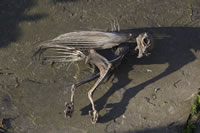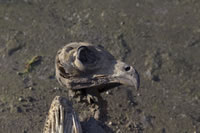April 2014
Unusual bird ID
19/04/14 22:24
Had our chimney swept for the first time in far too long.
Sadly this bird was in the chimney and looks like he had been there for some time. He was ringed, which read:
BTO British Museum
Nat History London
GF 01954.


We are awaiting a reply from the BTO or Natural History Museum, in the meantime the best guess (thanks to the kind people on Wild About Britain) is some sort of owl.
Sadly this bird was in the chimney and looks like he had been there for some time. He was ringed, which read:
BTO British Museum
Nat History London
GF 01954.


We are awaiting a reply from the BTO or Natural History Museum, in the meantime the best guess (thanks to the kind people on Wild About Britain) is some sort of owl.
Pecking order
19/04/14 22:20
idly watching the feeders today with a rather fat wood pigeon sat on top of the fat nibbles idly scaring off a couple of blackbirds who were trying to sneak underneath.
Equally large crow landed on the branch above and gradually inched his way down until the woodie took the hint and flew off.
Three woodies then gathered together and made as if they were going to mob the crow but decided against...
Equally large crow landed on the branch above and gradually inched his way down until the woodie took the hint and flew off.
Three woodies then gathered together and made as if they were going to mob the crow but decided against...
Moorland birds
17/04/14 23:17
The coming of spring sees the return of moorland birds in greater numbers. A recent jaunt up Saunder Height confirmed the return of meadow pipits and lapwings, no skylarks as yet. The ubiquitous crows are there of course and have recently been joined by common gulls, a less welcome sight.
The conservation watcher website has a graphic of moorland birds plotted against habitat - deep heather, grazed heather and short grass.
http://www.conservationwatcher.com/grazingandmoorlandbirds.RSPB.2001.html
This suggests that short grass, like Saunder Height which is pretty well grazed, is preferred by wheatear, skylark, golden plover and snipe with mipi, curlew, snipe and whinchat also populating. Saunder Height seems to fit this with last year’s reports to the BTO birdwatch consisting mainly of skylarks, meadow pipits and lapwings. Together with crows and gulls of course. They are joined by the occasional wheatear, not many curlew and no golden plover or whinchat as yet.
The conservation watcher website has a graphic of moorland birds plotted against habitat - deep heather, grazed heather and short grass.
http://www.conservationwatcher.com/grazingandmoorlandbirds.RSPB.2001.html
This suggests that short grass, like Saunder Height which is pretty well grazed, is preferred by wheatear, skylark, golden plover and snipe with mipi, curlew, snipe and whinchat also populating. Saunder Height seems to fit this with last year’s reports to the BTO birdwatch consisting mainly of skylarks, meadow pipits and lapwings. Together with crows and gulls of course. They are joined by the occasional wheatear, not many curlew and no golden plover or whinchat as yet.
Leucistic crow?
05/04/14 21:27
We saw a bird on the garden fence the other morning, size about that of a jackdaw, upright stance, crow like black beak. Black head/back/wings, beige throat/breats/sides/belly. Legs I think black but not sure.
It looked a bit like a female bullfinch but:
much bigger
black down all of back
no white rump/wingbars
or a bit like the South Asian House Crow but:
black down entire back
in East Lancashire!
A more sensible suggestion was that of a hooded crow but again the black/pale distribution wasn’t right and there have been no recent reports of hooded crows mating in Lancs. Hybrid hooded/carrion crows have been reported from time to time, mainly near the coast but a pair in Clitheroe in 2008.
Clitheroe isn’t too far from here but it’s unlikely.
More likely, it was a leucistic crow/jackdaw. Leucism occurs when a genetic mutation prevent the normal expression of melanin (usually) in the plumage, leaving the bird with a ‘bleached-out’ look. Whilst they may be of interest to birders, leucistic birds are exposed to predators (as they lack the usual camouflage) and may struggle to attract mates.
Sadly, it didn’t stay long enough to be photographed.
It looked a bit like a female bullfinch but:
much bigger
black down all of back
no white rump/wingbars
or a bit like the South Asian House Crow but:
black down entire back
in East Lancashire!
A more sensible suggestion was that of a hooded crow but again the black/pale distribution wasn’t right and there have been no recent reports of hooded crows mating in Lancs. Hybrid hooded/carrion crows have been reported from time to time, mainly near the coast but a pair in Clitheroe in 2008.
Clitheroe isn’t too far from here but it’s unlikely.
More likely, it was a leucistic crow/jackdaw. Leucism occurs when a genetic mutation prevent the normal expression of melanin (usually) in the plumage, leaving the bird with a ‘bleached-out’ look. Whilst they may be of interest to birders, leucistic birds are exposed to predators (as they lack the usual camouflage) and may struggle to attract mates.
Sadly, it didn’t stay long enough to be photographed.




